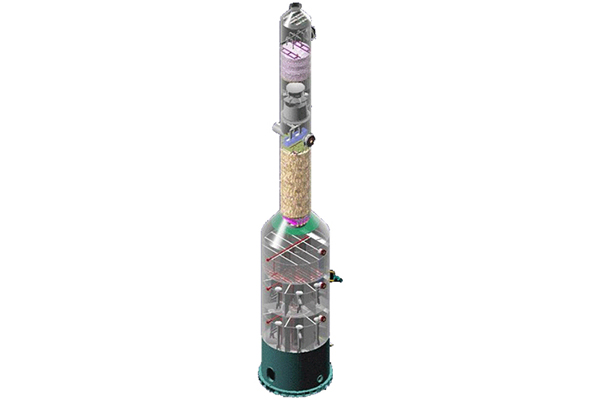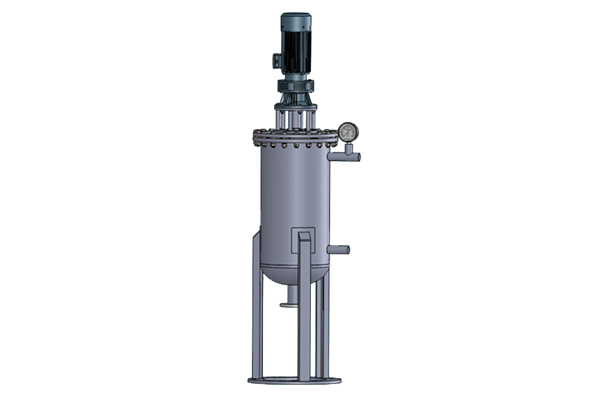What is the mechanism of the unique tower internal component design of the paraffin analysis tower to improve the depth of wax crystal growth and separation?
Release Time : 2024-12-12
As a key equipment in the tail gas recovery system of a large leaching workshop, the unique tower internal component design of the paraffin analysis tower plays a vital role in the growth and separation of wax crystals, and there is a complex and exquisite mechanism behind it.
The packing components in the tower are one of the key factors affecting the growth of wax crystals. The specially designed packing has a large specific surface area and a suitable pore structure. When the wax-containing mixture enters the tower and contacts the packing, the wax molecules are adsorbed on the surface of the packing. The rough surface of the packing provides nucleation sites for wax crystals, allowing wax crystals to begin to grow on them. Moreover, due to the pore structure of the packing, the wax-containing solution can form local flow rate changes and concentration gradients in it. This flow rate change slows down the movement of wax crystals, giving them enough time and space to grow and aggregate, and promoting small wax crystals to gradually grow into larger and more regular crystal structures, which is beneficial to subsequent separation operations.
The baffle components in the tower have a unique mechanism of action in the wax crystal separation process. The layout and angle of the baffles are carefully designed to change the flow direction and flow pattern of the wax solution in the tower. When the wax crystals flow with the solution, the baffles cause the originally relatively uniform flow field to produce disturbances. On the one hand, the disturbance promotes the relative movement between the wax crystals and the solution, increases the probability of collision between the wax crystals, and enables the already formed larger wax crystals to further agglomerate and combine to form larger particle clusters, thereby improving the overall sedimentation performance of the wax crystals. On the other hand, the baffles can guide the solution to form different flow areas, forming relatively calm sedimentation areas in certain areas, making it easier for the wax crystals to settle to the bottom of the tower under the action of gravity, thereby achieving effective separation from the solution.
In addition, the distributor components in the tower also play an important role in the growth and separation of wax crystals. The distributor can evenly disperse the wax solution entering the tower to various areas, ensuring that the growth conditions of the wax crystals in the entire tower section are relatively consistent. This can avoid the situation where the local wax crystals grow too fast or too slow due to uneven distribution of the solution, and improve the uniformity and stability of the wax crystal growth. During the separation stage, evenly distributed wax crystals are more likely to be separated in an orderly manner by baffles and gravity, reducing the problem of low separation efficiency caused by local accumulation or poor flow, thereby improving the overall effect of the paraffin analysis tower on wax crystal growth and separation, ensuring the efficient and stable operation of the tail gas recovery system, and laying a solid foundation for the optimization of paraffin production technology and the effective use of resources.
The packing components in the tower are one of the key factors affecting the growth of wax crystals. The specially designed packing has a large specific surface area and a suitable pore structure. When the wax-containing mixture enters the tower and contacts the packing, the wax molecules are adsorbed on the surface of the packing. The rough surface of the packing provides nucleation sites for wax crystals, allowing wax crystals to begin to grow on them. Moreover, due to the pore structure of the packing, the wax-containing solution can form local flow rate changes and concentration gradients in it. This flow rate change slows down the movement of wax crystals, giving them enough time and space to grow and aggregate, and promoting small wax crystals to gradually grow into larger and more regular crystal structures, which is beneficial to subsequent separation operations.
The baffle components in the tower have a unique mechanism of action in the wax crystal separation process. The layout and angle of the baffles are carefully designed to change the flow direction and flow pattern of the wax solution in the tower. When the wax crystals flow with the solution, the baffles cause the originally relatively uniform flow field to produce disturbances. On the one hand, the disturbance promotes the relative movement between the wax crystals and the solution, increases the probability of collision between the wax crystals, and enables the already formed larger wax crystals to further agglomerate and combine to form larger particle clusters, thereby improving the overall sedimentation performance of the wax crystals. On the other hand, the baffles can guide the solution to form different flow areas, forming relatively calm sedimentation areas in certain areas, making it easier for the wax crystals to settle to the bottom of the tower under the action of gravity, thereby achieving effective separation from the solution.
In addition, the distributor components in the tower also play an important role in the growth and separation of wax crystals. The distributor can evenly disperse the wax solution entering the tower to various areas, ensuring that the growth conditions of the wax crystals in the entire tower section are relatively consistent. This can avoid the situation where the local wax crystals grow too fast or too slow due to uneven distribution of the solution, and improve the uniformity and stability of the wax crystal growth. During the separation stage, evenly distributed wax crystals are more likely to be separated in an orderly manner by baffles and gravity, reducing the problem of low separation efficiency caused by local accumulation or poor flow, thereby improving the overall effect of the paraffin analysis tower on wax crystal growth and separation, ensuring the efficient and stable operation of the tail gas recovery system, and laying a solid foundation for the optimization of paraffin production technology and the effective use of resources.








